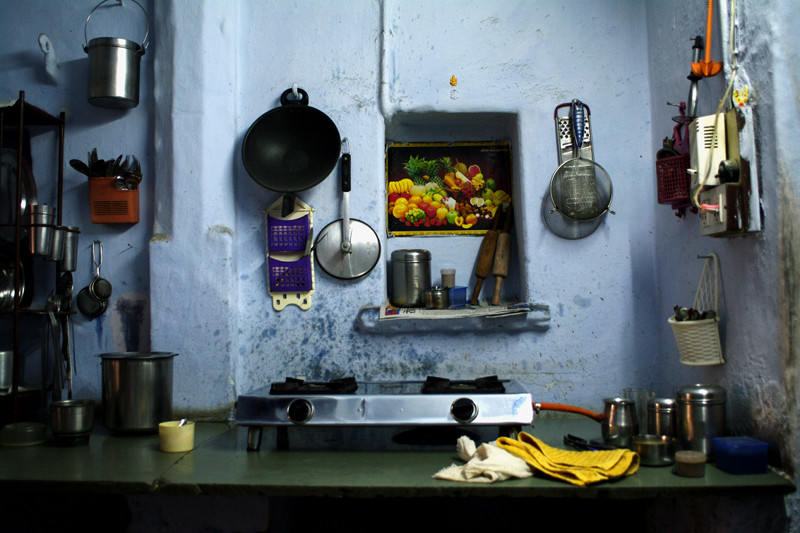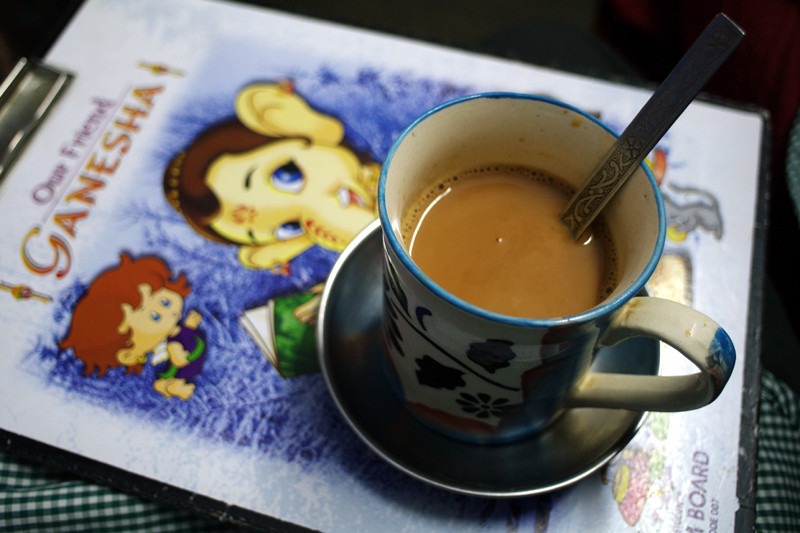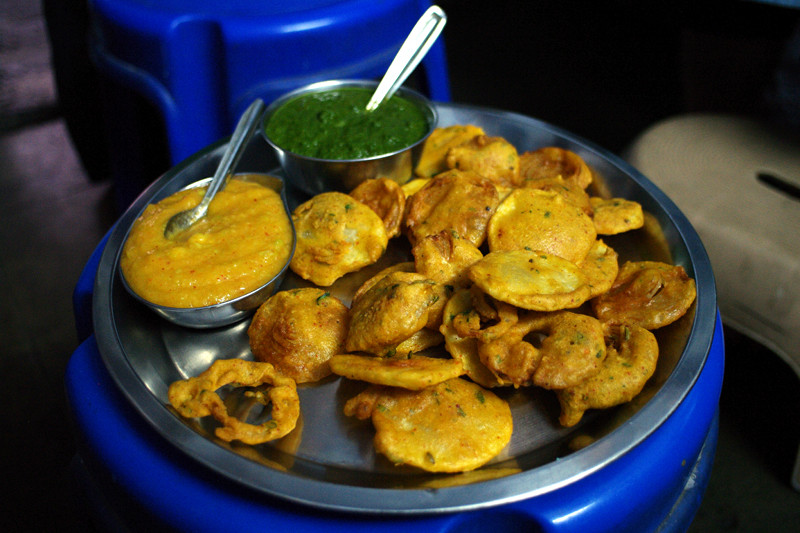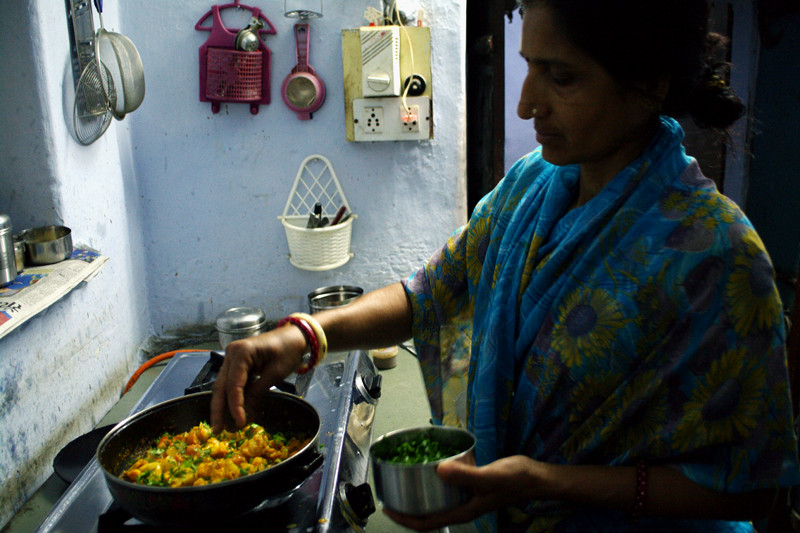Indian cooking
We took a day train from Jaipur to Udaipur. We arrived at night and went to a nice hotel that had been recommended to us. Of the rooms they showed us, we particularly liked the one painted blue on the second floor overlooking Lake Pichola. It was 2500 Rs/night (almost $60—a splurge in our budget), and had it been daytime we probably would have tried to talk down the price (it being low season), but it was already past 10pm, we’d been traveling all day, and just wanted to go to bed. However when we woke up and saw the room and the view out over the lake in daylight, we realized we’d made an excellent choice (bargain or not). We ended up spending six nights there.

Panoramic view from our hotel room overlooking Lake Pichola
The old city of Udaipur, though definitely catering to visitors with its shops and restaurants, had the feel of a French village with narrow, crooked streets walled in by tall buildings. It was a place that invited you to explore on foot. Some corners were relatively quiet with little traffic. And there were things to do. Stephanie underwent a 45 minute ayurvedic full body massage and took a 2 hour painting class that stretched out to two days. And as is our custom, we signed up for a cooking class, this one taught by Shashi—at the time not only the highest ranked cooking class in Udaipur on Trip Advisor, but the highest ranked activity of any sort in Udaipur.
A rough paraphrase of Shashi’s life story goes like this: she grew up in a small village in Rajasthan, speaking only Rajasthani. Her marriage was arranged to a man from Udaipur who spoke only Hindi. So she moved to Udaipur and started to learn Hindi. After only a few years of marriage, her husband was murdered by his best friend. Shashi was now a young widow with two children. She was expected to mourn at home for a year. Remarrying was out of the question. She received no financial assistance from her mother- and father-in-law, though she was expected to continue cooking and cleaning for them. She became very depressed. She cleaned tourists’ clothes in secret (which one of her young sons would collect from local guesthouses) because Brahmins, the caste she belonged to, are not supposed to touch dirty clothes. She was shunned by the community because many people regard widows as bad luck. She could only go out at night. She did some cooking at a local restaurant, and one day one of the guests asked if she would teach him how to cook. At this point she spoke no English, but she learned a handful of cooking words to get by. Word spread, and more people asked her to teach them how to cook. Her English got better. Someone wrote down her recipes in English. Someone translated them to French, someone else to Spanish, German, Portuguese, etc. Someone from Lonely Planet reviewed her class. Someone set up a website for her. Now she is busy teaching, able to support herself and her sons independently, thanks to a cast of unlikely supporters from around the world.

Six of us met at 5:30, and we all crowded into Shashi’s diminutive kitchen for 5 hours. She provided us with printouts of about 20 recipes, some with several variations. Our menu for the evening included:
- Masala Chai
- Pakora
- Mango Chutney, Cilantro Chutney
- Vegetable Palau (also: pulau, polau)
- Aloo Gobi (potato and cauliflower curry)
- Naan with cheese and tomato
- Chapati
- Parantha, Aloo Parantha, Sweet Parantha
Masala chai is something we’ve had with almost every breakfast (and sometimes lunch) since we arrived in India. I’ve seen it translated as “milk tea” but I didn’t realize until I saw Shashi make it that it’s literally loose tea leaves (Darjeeling or Assam) brewed in milk. Add to this plenty of sugar (2 tbsp per cup) and masala tea powder (which you can make fresh by crushing in a mortar and pestle: 2 cardamom pods, 4 black peppercorns, and a fingertip of ginger, per cup), simmer for 4 minutes, pour through strainer, and serve. Super-yummy and super-caffeinated—I had a mug at 6pm and didn’t get to bed until after 4 in the morning!

Once we’d had our tea, Sashi got down to business. She did most of the cooking herself, all the while telling stories and elaborating as she went. Occasionally she’d ask for assistance from one or two of us to stir a pot, crush something in the mortar and pestle or knead dough.
To start she made three batches of pakora, the popular battered and fried vegetable starter. First was sliced onions and potatoes, then paneer and cauliflower, and finally chopped vegetables with green onion. But the real scene-stealers were the tangy chutneys: cilantro (aka coriander) and mango. My mental picture of chutney was more like a chunky salsa, but she put all the ingredients in a blender and pureed them until smooth, which made for a perfect dipping complement to the chubby pakora, and I imagine could be used in place of salsa for so many things.
Cilantro chutney
- 1 cup of chopped cilantro with stems (or mint, without stems)
- 3 cloves of garlic
- 1 green chili
- 1/4 tsp salt
- a little water
Blend until smooth. Stir in juice from 1 lemon.
Mango chutney
- 1 green mango (omit sugar for yellow mango)
- 3 cloves garlic
- 1/2 tsp salt
- 1/2 tsp red chili powder
- 1 tbsp sugar
- a little water
Blend until smooth.

After we’d feasted on pakora and chutney—the class could have ended there based on the state of our stomachs—she began working on the two main dishes, vegetable palau and aloo gobi. Palau, also known in English as pilaf, is a dry rice and vegetable dish, similar to biryani, but not one that I’m the biggest fan of. It’s not bad, it just doesn’t stand out for me like the wet Punjabi curries with plain basmati rice. The interesting thing about the aloo gobi was learning that it and a dozen other dishes can be made using the same masala base simply by varying the addition of a few key ingredients or vegetables.

But the real treat was getting to make the various Indian breads from scratch. Even though I’ve always loved to cook, there’s still something about baking I find magical, if not mystical. Perhaps because a cooked dish always feels like a combination of its various elements, while bread itself seems elemental, atomic.
We learned that naan, the ubiquitous light and fluffy flat bread served in Indian restaurants throughout the US, is rarely eaten by Indians except at weddings. I also had no idea it’s made from flour and yogurt! The daily bread for most Indians, at least in the north, is chapati (aka roti), made with whole wheat flour, water, and salt.
To make 4-5 chapatis, knead together 1 cup of whole wheat flour, 1 cup of water, and a pinch of salt to form a dry, rough dough. Take a small piece and roll it in your hand firmly until there are no cracks. Using a rolling pin, gently roll it out, forming a circle about 6-7 inches across. Place it on a hot tawa (a polished, concave hot plate) sitting over a gas burner until small bubbles start to appear. Flip. Using a clean hand towel scrunched into a ball, press down and rotate the chapati on the tawa at the edges to brown it. Flip again and repeat the motion with the towel until the chapati begins to inflate. Remove to a container (with towel at bottom) to keep warm while cooking the rest.

Turning flour and water into chapatis that were indistinguishable from the ones that we’ve eaten with most meals was very cool. However transforming the humble chapati into an aloo parantha was even cooler, and stands out as one of my favorite food discoveries in India so far.
Essentially aloo parantha is a fried chapati with a seasoned potato mixture “stuffed” inside, commonly eaten at breakfast. The method of stuffing is not what you might imagine. To make one, boil and mash one medium-sized potato, mixing in a pinch of salt, anise, garam masala, red chili, oregano, a handful of chopped cilantro, and a squirt of lemon juice. Once the chapati (using the recipe above) is rolled out into a circle, form the potato mixture into a ball and place it in the center of the dough. Gently fold up the edges of the dough over the mashed potato, making an octagon. Use a rolling pin to roll the “dumpling” into a circle again, taking care not to puncture the dough: voila, stuffed parantha! Then cook on the tawa (or hot plate) with a little bit of oil on each side until lightly browned. Your taste buds will thank you.
